Prostitution was widespread in Rome in ancient days as Romans demanded such services. The Roman government was even working towards regulating the sexual service issue. The industry of prostitution was a substantial revenue generator for the Roman empire.
The people involved in the sexual services ran a significant economy of Rome as the government levied taxes on prostitutes and the people of the elite class invested in brothel management.
It was the oldest profession and maintained a strong presence in ancient Rome.
As the people from low economic levels were used as slaves, the high-level people could decide how to use their slaves as they were considered private properties.
Most prostitutes took the profession not because they wanted to but were forced into it since prostitution was the easiest way to earn money.
Prostitution wasn’t looked upon well in ancient Rome, even though it was legal. It was considered a shameful profession as they used their bodies to make money.
For the same reason, they thought professions Roman gladiators, musicians, and actors as shameful professions.
What was the life of a prostitute like?
Content
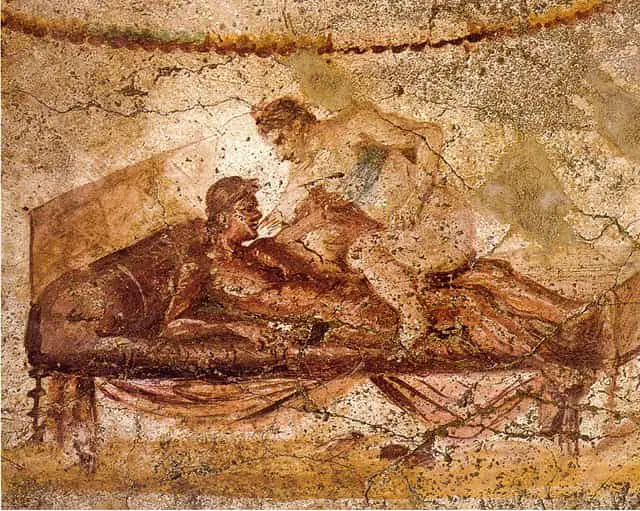
Source: Wikimedia Common
Prostitutes, in around the second century BCE, had to be registered and get a permit to enter such service. They belonged to various social classes: the lowest being the daughter of slaves and the highest being luxurious escorts who were very expensive.
However, prostitution was barely a luxury since the elites could be intimate with any slave they wished. This act had no consequence and was most common among the people belonging to the poor class.
Prostitution imposed by fathers existed in ancient Rome. Later, they set a new rule of law that stated the father who forced his daughter into prostitution lost his rights to her.
The Romans commonly organized orgies with prostitutes, where they beat women with sandals and whips. Abortion was another common practice during that time where it was done using spells, toxic lead-white, and sometimes charms.
The prostitutes could be identified by their clothing. They would either flaunt their naked bodies or wear straw belts. Others wore short tunics or robes without sleeves, primarily green in color.
The main identifying factor was the green show and blonde hair, sometimes decorated with a floral crown. However, they were not allowed to wear golden jewelry, purple lingerie, or embroidery.
What were the different types of prostitutes in ancient Rome?
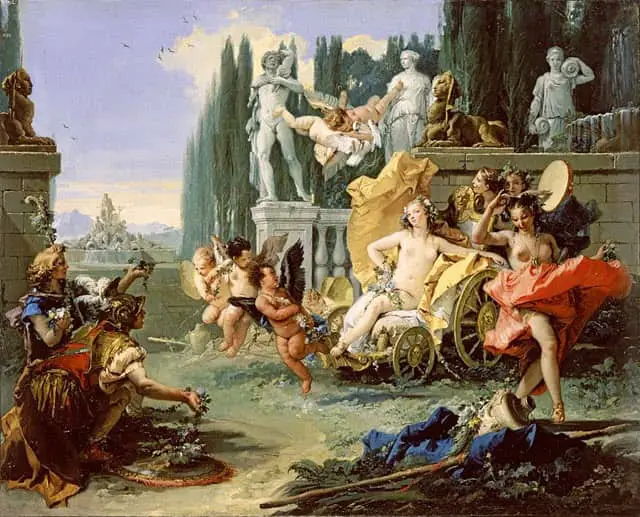
Source: Wikimedia Common
Roman prostitutes were divided into two categories: the meretrices, the upper-class prostitutes, registered and credentialed, and prostitutes, who were the unregistered prostitutes. Different varieties of prostitutes belong in the second category, such as:
Aelicariae- prostitutes who stood before the bakers and sold cookies shaped like male and female reproductive organs.
Amatrix- lesbian playing the role of a man
Ambubiae- singing women, primarily prostitutes
Blitidae- low-class prostitutes who lured men into taverns with cheap wine
Busturiae- prostitutes offering services in cemeteries, on the tombs
Citharistriae- harpists, mostly prostitutes
Delicate- prostitutes for love
Doris- naked beautiful women
Meretrix- registered prostitutes
Naniae- children up to 6 years old, forced into prostitution
Noctilucasae- availably only during the night
Prostitute- unregistered prostitutes standing before her looking to get clients.
Quadrantariae- old prostitutes who were no longer attractive
What took to flourish a career as a prostitute?
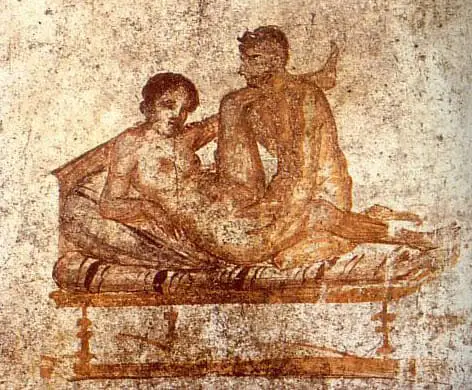
Source: Wikimedia Common
In ancient Rome, prostitutes had to catch their clients’ attention. This was primarily based on self-presentation, also known as artesmeretriciae. It consisted of information regarding social rules, beauty tips, and other basic principles.
They had to wear a short tunic with a very simple toga and appeared naked or sometimes with naked breasts in the brothels. It was famous for wearing short-transparent clothes.
Prostitutes were fond of make-up and body care products, and perfume overuse was widespread. Haircuts were very significant, and blondes were considered very desirable. Prostitutes who did not have pubic hair would be highly valued, but the hair removal process was not the most pleasant experience as they used to burn lime during baths or use some arsenic.
They focused on cleanliness precisely and would manage time to clean after each client’s visit as unhygienic sex was seen as heavily disgusting. And the ones who could not keep themself clean and hygienic would often lose their clients.
The prostitutes used two common positions: missionary and straddling her client. The process was impersonal and brutal since their only intention was to fulfill every want of the man and satisfy him.
What were the brothels like?

Source: Wikimedia Common
The Romans called brothels Lupanar, derived from the word Lupa- meaning she-wolf. Prostitutes were commonly found in inns, pillared halls, temples, theatres, baths, circuses, exit roads, cemeteries along the road, military camps, and brothels.
There were various types of brothels. Some were a building designed to be a brothel. Others were inns, taverns, and bakeries, which provided sexual services and single rooms opening into the streets.
The brothels ran extreme marketing campaigns to attract new clients, such as keeping erotic phallus lamps or symbols and arts on the ceilings, painting graffiti on the walls, and writing on the soles.
Still, the easiest way for a prostitute to bring clients was by sitting in front of the house naked or dressed scantily.
Who were the clients in the prostitution business?
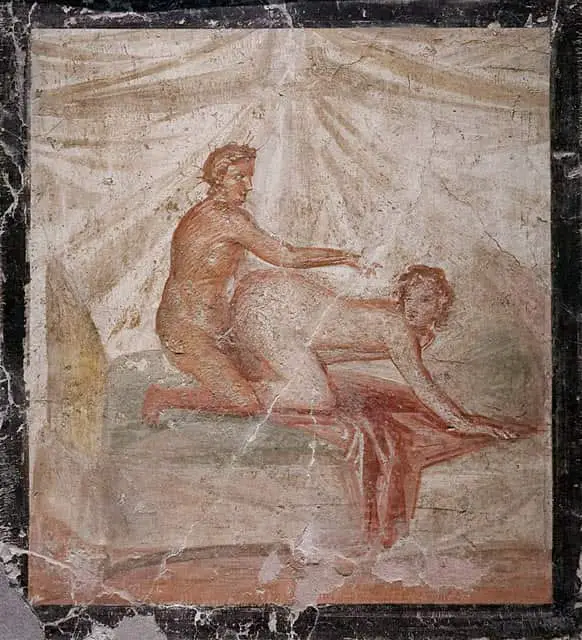
Source: Wikimedia Common
In ancient Rome, people did not accept a man having his first time with a future wife or matron; thus, prostitution was the only means of men’s sexual initiation. Sons did not find using prostitutes’ services unusual as they know their fathers used it as well.
Fathers even encouraged them to visit brothels since the initiation of sexual life was a sign of adulthood and masculinity. However, older men visiting brothels were frowned upon as they could not control their sexual desires.
According to society, only men required sexual fulfillment, and women- neither prostitutes nor wives- could lead a free sexual life. Even showing affection to women was considered secondary as the only purpose of sexual contact was for procreation.
Most of the brothel visitors were slaves and freedmen for whom using prostitutes’ service was the only way to fulfill their sexual needs. Upper-class men used escort services and kept in close contact with them.
What was the role of the pimps?
Male pimps were called leones, whereas female pimps were called legal and had an infamous role in society, so they were highly unwelcomed. Caupones, the tavern owners, also engaged in such business on a small scale.
Besides food and drinks, they also rented rooms for sexual services. Bakers and hairdressers were involved in it as well.
Prostitutes found children and raised them, mainly their daughters, to make them work for them in the future. The prostitution of free children was not illegal. However, they still considered it one of the most wicked things in Roman society. It was followed by impending starvation.
Professional pimps owned or rented brothels, whereas individual pimps did not necessarily manage street prostitutes. Pimps got the slaves usually from slave markets, buying children from poor parents, or raising children or children born in brothels.
What kind of earning did a prostitute make?
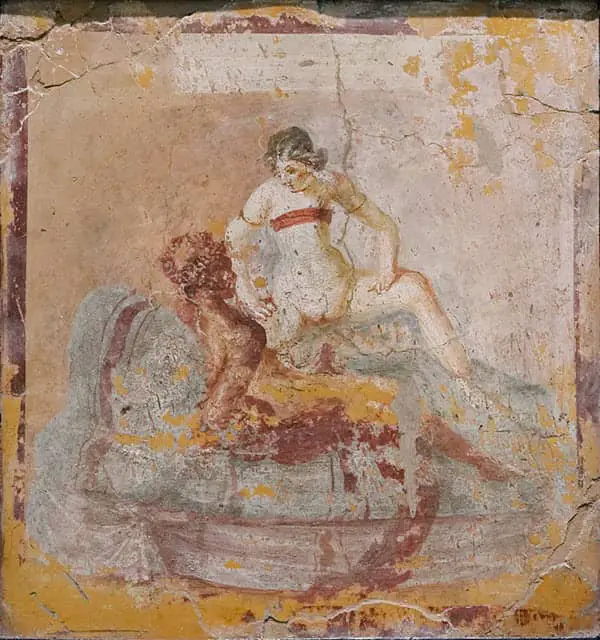
Source: Wikimedia Common
The average fee for prostitutes was between two and sixteen asses ( equivalent to one denarius) but could go as low as less than one.
Quadrantaria, the lowest class of prostitutes, would be paid one-quarter of an as, whereas significantly well-paid courtesans would make from two to twenty-three asses. A loaf of bread amounted to 2 asses at the time.
Prostitutes who demanded more money got fewer clients, and virgins were paid high fees. They considered prostitutes less attractive as they aged, so they got rejected more often.
Prostitutes who worked for pimps received less as most of the money would be taken by the pimp.
What were the laws regarding prostitution in Ancient Rome?
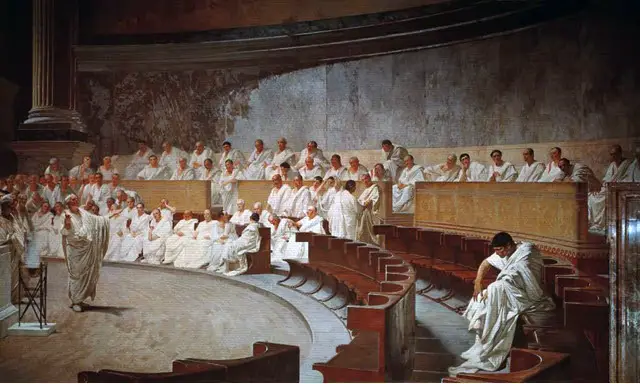
Source: Wikimedia Common
The government made many attempts to control prostitution; however, banning it was not considered till later.
Lex lulia et Papia was a critical law where the upper classes were forbidden to marry prostitutes. Lex lulia de adulteriis was another law that regulated the exceptions of strict customary law, which excused prostitutes a penalty for adultery and kept the trade of people under control.
Prostitutes were not safe from sexual harassment and raping and were helpless about it. It was doubtful if invading a closed room and raping a prostitute slave was rape. The law did not entertain forced prostitution.
There were Roman laws against child prostitution and forcing slaves into prostitution, and they were protected by Roman law. However, these laws have been disregarded many times in history.
Taxes were charged to prostitutes and pimps since the reign of Caligula, which was equivalent to one intercourse with a prostitute.
Conclusion
Prostitution was legal and licensed in ancient Rome and was common among men from lower social statuses. Brothels were a popular entertainment place; men usually initiated their sexual life with a brother, stepped into adulthood, and attained manhood.
It was common for prostitutes to dress differently than in the city, where they wore special robes with a very short tunic underneath or displayed themselves naked. They were mainly distinguished from the Roman women by their bright blond hair.
The prostitutes had to be registered and licensed, and the pimps paid certain taxes. These taxes were a significant source of the state treasury. They would be found standing in pillared buildings, theatres, cemeteries, bakeries, taverns, inns, or even in the streets, looking for possible clients.
